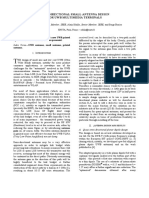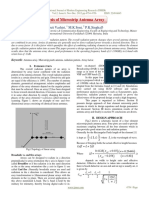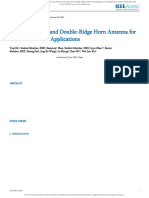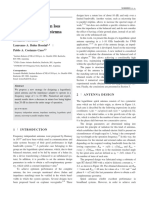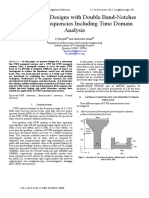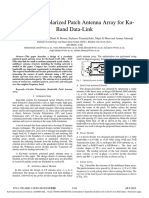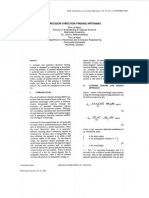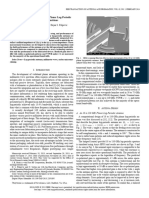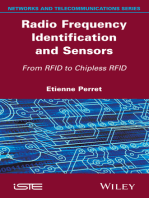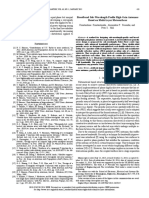A Reconfigurable Beam-Scanning Partially Reflective Surface (PRS) Antenna
A Reconfigurable Beam-Scanning Partially Reflective Surface (PRS) Antenna
Uploaded by
BindhuCopyright:
Available Formats
A Reconfigurable Beam-Scanning Partially Reflective Surface (PRS) Antenna
A Reconfigurable Beam-Scanning Partially Reflective Surface (PRS) Antenna
Uploaded by
BindhuOriginal Title
Copyright
Available Formats
Share this document
Did you find this document useful?
Is this content inappropriate?
Copyright:
Available Formats
A Reconfigurable Beam-Scanning Partially Reflective Surface (PRS) Antenna
A Reconfigurable Beam-Scanning Partially Reflective Surface (PRS) Antenna
Uploaded by
BindhuCopyright:
Available Formats
A Reconfigurable Beam-Scanning Partially
Reflective Surface (PRS) Antenna
Lu-Yang Ji1, Y. Jay Guo2, Pei-Yuan Qin2, Guang Fu1
1
School of Electronic Engineering, Xidian University, Xi’an, China, luyangji078@gmail.com
2
Faculty of Engineering and IT, UTS, Sydney, Australia, jay.guo@uts.edu.au
Abstract— A novel reconfigurable partially reflective surface
(PRS) antenna is presented in this paper. The beam scanning
PIN diode Resistor
ability is realized by employing a reconfigurable PRS structure Capacitor Inductor
and a phased array as the source. The design achieves a beam
Port2 Port3
switching between -15°, 0°, to 15°with respect to the broadside
direction from 5.5 GHz to 5.7 GHz with the realized gains over Wf
t g2
12 dBi. Good agreement between the simulated and measured g1
results is achieved.
dslot
Index Terms— reconfigurable PRS antenna, beam scanning,
phased array antenna.. V1 Lslot V2
Lg
Wslot
I. INTRODUCTION Biasing
pad
A high-gain, low-profile beam scanning antenna has many Gap
Stub
applications, such as cellular base stations and satellite
communications. A conventional way to realize beam steering Via to the x
is to utilize a phased array antenna, but it has the drawbacks of ground
y
high cost and bulky structure [1]. Pattern reconfigurable Port1
antennas can provide a low-cost alternative to phased arrays Fig. 1. Structure of the feed network
and they have attracted significant attention from both
academia and industry [2]. However, most of the reported a function of the reflection magnitude of the PRS as following
designs suffer from low realized gains. It is well known that a
partially reflective surface (PRS) antenna can achieve a high 1-R
gain with a fixed broadside beam. It would be more useful if Demax =
1+R
its beam can be reconfigured. Recently, a few PRS antennas
have been presented that have the capabilities to switch the Generally, a center-fed PRS antenna produces a broadside
main beam direction [3-4]. beam. In this design, a phased array patch antenna is utilized as
This paper proposes a new pattern reconfigurable beam- the source of the PRS antenna to realize beam steering. To
scanning PRS antenna which employs a reconfigurable PRS obtain phase shifts between the array elements, reconfigurable
and a 2-element microstrip patch phased array as the source. defected microstrip structure (RDMS) based phase shifter [6]
The antenna can steer its beam between -15º, 0º, and 15ºfrom are incorporated in the feed network as shown in Fig.1. Each
5.5 GHz to 5.7 GHz (beam steering range of 30°) with a phase shifter consists of 3 identical RDMS units, as shown in
realized gain over 12 dBi. It employs a simple biasing network the inset of Fig. 1. Each unit consists of a rectangular slot with
and its phase shift network for the array source is integrated a size of Lslot × Wslot ; two gaps etched on the edges for
into the antenna, leading to a compact structure. inserting the PIN diodes; and two metallic stubs located in the
middle of the slots as mounting pads for the capacitors not
II. ANTENNA GEOMETRY only to realize RF continuity, but to provide DC isolation for
A. Design of a PRS antenna with a phased array source the PIN diodes as well. The dimensions of the RDMS unit are
listed in Table I. The phase shift is achieved by controlling the
A conventional PRS antenna is composed of a source states of the PIN diodes of the RDMS unit. The current path
antenna embedded between a ground plane and a dielectric for the off- state of the PIN diodes is longer than that of the
superstrate employed as the PRS. The PRS is usually placed
about half a wavelength above the ground plane with a TABLE I DIMENSIONS OF THE RDMS UNIT
reflection coefficient Γ=R∙ exp(jφ) . The electromagnetic Parameter Wf Lslot Wslot Lg
waves radiating from the source experience multiple Value (mm) 3.4 3.5 2.0 1.55
reflections within the cavity. According to the ray theory [5], a Parameter dslot g1 g2 t
maximum directivity at the broadside can be calculated as Value (mm) 4.2 0.4 0.7 0.65
PRS
obtained compared to that of the off-state. As shown in Fig.3
FR4
microstrip patch (b), the entire PRS structure composed of such reconfigurable
aperture-coupling-fed z
elements is divided into two halves with opposite orientation
30 mm
antenna array
y
θ of PIN diodes.
Rogers aperture
The above reconfigurable PRS structure can realize an
4003 additional ±5 beam tilting on the basis of the previous phased
network array fed PRS antenna. By the combination of the
feed network ground plane
reconfigurable PRS structure and the phased array source, the
Fig. 2. Phased array fed PRS antenna (a) side view, and (b) top view proposed antenna can realize a ±15 beam tilting with respect
to the broadside direction. Moreover, instead of using a
on-state. For this design, the off-state generates a 30ºphase separate power divider and a reconfigurable matching network
delay with respect to the on-state for a single unit. By [4], the proposed antenna employs an integrated aperture-feed
cascading three RDMS units, a 90ºphase shift can be obtained. network for the phased array source and does not require an
The schematics of the entire phased array PRS antenna are extra impedance matching network; leading to a more compact
shown in Fig. 2. The dimensions of the antenna are 170 mm × structure.
170 mm. The phased array source is a two-layer structure. For
the first layer, two square microstrip patches with a size of III. ANTENNA PERFORMANCE
13.2 mm are placed at one side of a 1.524-mm-thick Based on the analysis and results shown in Sections II, a
Rogers4003 substrate and aligned symmetrically along the y PRS antenna with a reconfigurable PRS structure and a phased
direction. The spacing between them is 43 mm. On the other array source has been designed, fabricated, and measured. The
side of the substrate, two slots coupling are etched on the reconfigurable PRS structure is the same as that shown in Fig.
ground at the position of the patch center. For the second layer, 3(b), which consists of 6 × 6 reconfigurable cells, with
the feed network is printed on the lower side of another 1.524- dimensions of 20.5 mm × 20.5 mm, printed on the lower side
mm-thick Rogers4003 substrate. A 6.5-mm-thick FR4 of a 0.8-mm-thick FR4 substrate. The structure of the phased
substrate is used as the PRS structure which is located 30 mm array source and its feed network are the same as that shown in
from the patch array. Fig. 2. However, the size of the array elements is changed to
By employing the reconfigurable phased array as the 12.2 mm after optimization. In this design, φ = −145.5° for
source, the PRS antenna can steer its beam towards 0, −10, an off-state is chosen as an initial value to calculate Lr. After
and 10 when the PIN diodes are “all on”, “left branch on with optimization, Lr is set to be 30 mm.
right off”, “left branch off with right on”, respectively. A prototype as shown in Fig.4 was built to verify the
B. The reconfigurable PRS structure proposed design. In this work, we examine three states: State 1
refers to the state in which the diodes in the PRS cells are all
To further increase the beam-tilted angle and to improve
switched off while those in the feed network are all turned on,
the realized gain, the PRS structure employs 6 × 6
to realize a broadside beam. State 2 represents the case when
reconfigurable cells. Each reconfigurable cell is composed of a
the diodes on the left half of both the PRS and the feed
20.5 mm × 20.5 mm microstrip patch etched on a 24 mm × 24
network are switched on while the diodes on the right half are
mm × 0.8mm FR4 substrate. A 1 mm slot is inserted in the
turned off, to realize a beam tilted towards −y direction. State 3
middle of the patch. PIN diodes are placed at the two sides of
is opposite to State2 and it realizes a beam titled to +y
the slot (Fig.3(a)). The reflection phase of the cell element can
direction.
be varied by switching the states of the diodes to produce a
Fig.5 shows the measured reflection coefficients. It is seen
reflection phase inconsistency between the two parts of the
that an overlapped impedance bandwidth from 5.5 GHz to 5.74
entire PRS structure, which in turn switches the beam of the
GHz is achieved. The radiation patterns in the H-plane (y-z
PRS antenna. When the PIN diodes are switched off, the two
plane) at 5.5 GHz are shown in Fig. 6. The simulated and
halves of the patch disconnect from each other, which results
measured results are seen to be in good agreement with each
in a surface with a high reflectivity and a small phase. When
other. It is observed that a broadside radiation is obtained at
the PIN diodes are switched on, a larger phase value is
V
Substrate
Metal x
20.5 mm
1 mm y
PIN
diode
20.5 mm
24 mm Grd Inductive strip lines
Fig. 4. Prototype of the proposed antenna
Fig. 3. Reconfigurable PRS (a) cell, (b) entire structure
IV. CONCLUSION
A novel reconfigurable beam scanning PRS antenna has
been proposed in this paper. It is composed of a reconfigurable
PRS structure and a phased array antenna as its source. Its
beam direction can be tilted between -15°, 0°, and 15°from 5.5
GHz to 5.7 GHz. Compared to other pattern reconfigurable
PRS antennas, the proposed antenna exploits two
reconfiguration mechanisms to achieve a larger beam tilt angle
without sacrificing the realized gains. A prototype has been
fabricated and measured to validate the proposed design.
REFERENCES
[1] D. Parker, and D. C. Zimmermann, “Phased arrays-Part 1: theory and
Fig. 5. Measured reflection coefficient. architectures,” IEEE Trans. Microw. Theory Tech., vol.50, no.3, pp.
678–687, Mar. 2002.
[2] P.-Y. Qin, Y. J. Guo, and C. Ding, “A beam switching quasi-yagi dipole
antenna,” IEEE Trans. Antenna Propag., vol.61, no.10, pp.4891-4899,
Oct.2013.
[3] A. Ourir, S. N. Burokur, and A. de Lustrac, “Electronic beam steering of
an active metamaterial-based directive subwavelength cavity,” in 2nd
European Conference on. Antennas and Propagation, Edinburgh,
Nov.2007.
[4] T. Debogovic, and J. Perruisseau-Carrier, “Array-fed partially reflective
surface antenna with independent scanning and beamwidth dynamic
control,” IEEE Trans. Antenna Propag., vol.62, no.1, pp.446-449,
Jan.2014.
[5] G. V. Trentini, “Partially reflecting sheet arrays,” IRE Trans. on
Antenna Propag., vol.4, no.4, pp.666-671, Oct.1956.
[6] C. Ding, Y. J. Guo, P.-Y. Qin, T. S. Bird, and Y. Yang, “A defected
microstrip structure (DMS)-based phase shifter and its application to
Fig. 6. Radiation patterns of the proposed antenna at 5.5GHz. beamforming antennas,” IEEE Trans. Antenna Propag., vol.62, no.2,
pp.641-651, Feb. 2014.
State 1. For State 2 and State 3, the beam directions are tilted
towards -15º and 15º from the broadside. The measured
realized gain is over 12 dBi for these three states.
You might also like
- High-Gain FabryProt Antenna With Reconfigurable Scattering Patterns Based On Varactor DiodesDocument9 pagesHigh-Gain FabryProt Antenna With Reconfigurable Scattering Patterns Based On Varactor DiodesAnurag PalNo ratings yet
- Conference Final3Document4 pagesConference Final3RanjithPerumalNo ratings yet
- SCI Volume 26 Issue 3 Pages 1714-1723Document10 pagesSCI Volume 26 Issue 3 Pages 1714-1723EdemialemNo ratings yet
- Design of A Ridged Waveguide Slot Antenna ForDocument4 pagesDesign of A Ridged Waveguide Slot Antenna ForUsman QureshiNo ratings yet
- 829-Research Article-3061-2-10-20181209Document6 pages829-Research Article-3061-2-10-20181209Harini VemulaNo ratings yet
- High Broadband WlanDocument4 pagesHigh Broadband WlanIhya UlumiddinNo ratings yet
- A Planar Bandpass Filter Using Butterfly Radial StubDocument4 pagesA Planar Bandpass Filter Using Butterfly Radial StubhosseinNo ratings yet
- 8 PDFDocument4 pages8 PDFsastry garuNo ratings yet
- Semi-Directional Small Antenna Design For Uwb Multimedia TerminalsDocument4 pagesSemi-Directional Small Antenna Design For Uwb Multimedia TerminalsDr-Gurpreet KumarNo ratings yet
- A Wideband CMOS Power Amplifier With 52 Peak PAE Employing Resistive Shunt Feedback For Sub-6 GHZ 5G ApplicationsDocument4 pagesA Wideband CMOS Power Amplifier With 52 Peak PAE Employing Resistive Shunt Feedback For Sub-6 GHZ 5G Applicationsmo moNo ratings yet
- Design of Dual-Band Antenna Using An Optimized Complementary Split Ring ResonatorDocument10 pagesDesign of Dual-Band Antenna Using An Optimized Complementary Split Ring ResonatorNabil DakhliNo ratings yet
- A Compact Uwb Antenna With Dual Band-Notch Characteristics Using Nested Split Ring Resonator and Stepped Impedance ResonatorDocument4 pagesA Compact Uwb Antenna With Dual Band-Notch Characteristics Using Nested Split Ring Resonator and Stepped Impedance ResonatorDr-Gurpreet KumarNo ratings yet
- ARTICULO 3 ANTENAS Design of A Low-Profile Dual-Polarized Stepped CORTE 3Document4 pagesARTICULO 3 ANTENAS Design of A Low-Profile Dual-Polarized Stepped CORTE 3Samir DiazNo ratings yet
- Apusncursinrsm 2019 8889154Document2 pagesApusncursinrsm 2019 88891549949409548No ratings yet
- A New Series-Fed Printed Dipole Array Antenna For SSRDocument5 pagesA New Series-Fed Printed Dipole Array Antenna For SSRGayatri KulageriNo ratings yet
- Shaw 2020Document3 pagesShaw 202056947sudhanshujoshiNo ratings yet
- Electrical Communication Engg. Dept., Indian Institute of Science, Bangalore, IndiaDocument5 pagesElectrical Communication Engg. Dept., Indian Institute of Science, Bangalore, Indianc_nemiNo ratings yet
- Analysis of Microstrip Antenna Array: Shruti Vashist, M.K Soni, P.K.Singhal3Document3 pagesAnalysis of Microstrip Antenna Array: Shruti Vashist, M.K Soni, P.K.Singhal3Kishor.ece. anuNo ratings yet
- Wideband Fabry-Perot Resonator Antenna With Two Complementary FSS LayersDocument9 pagesWideband Fabry-Perot Resonator Antenna With Two Complementary FSS LayersBindhuNo ratings yet
- 4.1.8 Electrical Design of Metal Space Frame Radomes, IEEE Trans.Document15 pages4.1.8 Electrical Design of Metal Space Frame Radomes, IEEE Trans.ln zNo ratings yet
- Design of Frequency-Selective Surfaces Radome For A Planar Slotted Waveguide AntennaDocument3 pagesDesign of Frequency-Selective Surfaces Radome For A Planar Slotted Waveguide AntennaTOUGHNo ratings yet
- Impact of Ultra-Wideband Antenna Application On Underground Object DetectionDocument6 pagesImpact of Ultra-Wideband Antenna Application On Underground Object DetectionWARSE JournalsNo ratings yet
- High-Gain Dual-Band Dual-Sense Circularly Polarized Spiral Series-Fed Patch AntennaDocument10 pagesHigh-Gain Dual-Band Dual-Sense Circularly Polarized Spiral Series-Fed Patch AntennaGloria Athala Enriquez de RoseroNo ratings yet
- Design and Simulation Based Studies of A Dual Band Antenna For Wlan/Wimax ApplicationDocument5 pagesDesign and Simulation Based Studies of A Dual Band Antenna For Wlan/Wimax ApplicationIjarcet JournalNo ratings yet
- For Group 14,17,46Document4 pagesFor Group 14,17,46sulemanmy998No ratings yet
- Design of Broadband Double-Ridge Horn Antenna ForDocument9 pagesDesign of Broadband Double-Ridge Horn Antenna ForBhavani Prasanna VeyeegandlaNo ratings yet
- Bandwidth Enhancement of Probe Fed Microstrip Patch Antenna: Parminder Singh Anjali Chandel Divya NainaDocument4 pagesBandwidth Enhancement of Probe Fed Microstrip Patch Antenna: Parminder Singh Anjali Chandel Divya Nainayusuf shabanNo ratings yet
- A Wideband Elliptic Printed Dipole Antenna Array: Zhen Tu, Guang-Qiu Zhang, Dong-Fang Zhou, Feng XingDocument3 pagesA Wideband Elliptic Printed Dipole Antenna Array: Zhen Tu, Guang-Qiu Zhang, Dong-Fang Zhou, Feng XingJuampi MochenNo ratings yet
- A City-Wide Smart Wireless Sewer Sensor Network Using Parasitic Slot Array AntennasDocument4 pagesA City-Wide Smart Wireless Sewer Sensor Network Using Parasitic Slot Array AntennaslevyoliviaNo ratings yet
- Enabling Technologies For Ultra Wideband Phased Array - GunnarssonDocument5 pagesEnabling Technologies For Ultra Wideband Phased Array - Gunnarssonvs11No ratings yet
- A Low-RCS and High-Gain Partially Reflecting Surface AntennaDocument5 pagesA Low-RCS and High-Gain Partially Reflecting Surface Antennazohairahmed009No ratings yet
- 1 - Design of High Return LossDocument7 pages1 - Design of High Return LosssaralabitmNo ratings yet
- AmeypaperDocument5 pagesAmeypaperamey salunkeNo ratings yet
- Design of Bow Tie Antenna in CST StudioDocument4 pagesDesign of Bow Tie Antenna in CST StudioHøussàéîn Bèn MéssâõûdNo ratings yet
- An RF Switching Circuit Using PIN Diode For A 2.4GHz Frequency Reconfigurable AntennaDocument4 pagesAn RF Switching Circuit Using PIN Diode For A 2.4GHz Frequency Reconfigurable Antennaعلي عدنانNo ratings yet
- Bowtie AntenaDocument8 pagesBowtie AntenaMU Strongest ChannelNo ratings yet
- AntenDocument6 pagesAntenvõ hoài namNo ratings yet
- Abstract:: A Coplanar Waveguide Bow-Tie Aperture Antenna Guiping Zheng, Atef 2 - Elsherbeni, and Charles E. SmithDocument4 pagesAbstract:: A Coplanar Waveguide Bow-Tie Aperture Antenna Guiping Zheng, Atef 2 - Elsherbeni, and Charles E. SmithSỹ RonNo ratings yet
- High-Gain Dual-Band Dual-Sense Circularly Polarized Spiral Series-Fed Patch Antenna - En.esDocument10 pagesHigh-Gain Dual-Band Dual-Sense Circularly Polarized Spiral Series-Fed Patch Antenna - En.esseykarimNo ratings yet
- The Investigation of PIN Diode Switch On Reconfigurable AntennaDocument4 pagesThe Investigation of PIN Diode Switch On Reconfigurable AntennaGayathri Devi KNo ratings yet
- Design of A Narrowband 2.45 GHZ Unidirectional Microstrip Antenna With A Reversed Arrow' Shaped Slot For Fixed Rfid Tag A...Document5 pagesDesign of A Narrowband 2.45 GHZ Unidirectional Microstrip Antenna With A Reversed Arrow' Shaped Slot For Fixed Rfid Tag A...Hamza KhanNo ratings yet
- Rectenna Serves 2.45-Ghz: Wireless Power TransmissionDocument4 pagesRectenna Serves 2.45-Ghz: Wireless Power TransmissionArnab PattanayakNo ratings yet
- UWB Antenna Designs With Double Band-Notches PDFDocument5 pagesUWB Antenna Designs With Double Band-Notches PDFAnnisa SalsabellaNo ratings yet
- A Circularly Polarized Patch Antenna Array For Ku-Band Data-LinkDocument2 pagesA Circularly Polarized Patch Antenna Array For Ku-Band Data-LinkTolgahan TÜYLÜNo ratings yet
- Document 1Document6 pagesDocument 1Alia JavedNo ratings yet
- A Compact and Precision Direction Finding A Cardioid Radiation PatternDocument4 pagesA Compact and Precision Direction Finding A Cardioid Radiation Patternmurthy tataNo ratings yet
- A Switchable-Frequency Slot-Ring Antenna Element For Designing A Reconfigurable ArrayDocument5 pagesA Switchable-Frequency Slot-Ring Antenna Element For Designing A Reconfigurable ArrayloganathanNo ratings yet
- Jees 2022 1 R 55Document9 pagesJees 2022 1 R 55YuryNo ratings yet
- Study of Microstrip Feed Line Patch AntennaDocument7 pagesStudy of Microstrip Feed Line Patch AntennaNabil DakhliNo ratings yet
- A Broad-Band Planar Quasi-Yagi AntennaDocument3 pagesA Broad-Band Planar Quasi-Yagi AntennaKamorn BandudejNo ratings yet
- A Survey Analysis of Reconfigurable MicrDocument5 pagesA Survey Analysis of Reconfigurable MicrMohamed ElkhatibNo ratings yet
- Folded Bow-Tie AntennaDocument8 pagesFolded Bow-Tie AntennaPunyatoya RautarayNo ratings yet
- Micro-Coaxial Fed 18 To 110 GHZ Planar Log-Periodic Antennas With RF TransitionsDocument5 pagesMicro-Coaxial Fed 18 To 110 GHZ Planar Log-Periodic Antennas With RF TransitionsAbraham KurienNo ratings yet
- Tong-K - A Dual Band Dual PolarizationDocument2 pagesTong-K - A Dual Band Dual PolarizationLacides Ripoll SolanoNo ratings yet
- Circular Co-Planar Inverted-F Antenna For UHF Machine-to-Machine CommunicationsDocument2 pagesCircular Co-Planar Inverted-F Antenna For UHF Machine-to-Machine CommunicationsMuhammad Iqbal Abdul AzizNo ratings yet
- A Logarithmic Spiral Antenna For 0.4 To 3.8 GHZDocument8 pagesA Logarithmic Spiral Antenna For 0.4 To 3.8 GHZStephan CarterNo ratings yet
- Pattern-Reconfigurable Yagi-Uda Antenna Based On Liquid MetalDocument5 pagesPattern-Reconfigurable Yagi-Uda Antenna Based On Liquid MetalVarsha RengaNo ratings yet
- A Novel Compact Tapered-Slot Antenna For GPR ApplicationsDocument5 pagesA Novel Compact Tapered-Slot Antenna For GPR ApplicationsMark NguyenNo ratings yet
- Design Considerations of Silicon Nitride Optical Phased Array For Visible Light CommunicationsDocument7 pagesDesign Considerations of Silicon Nitride Optical Phased Array For Visible Light CommunicationsPaola GongoraNo ratings yet
- Radio Frequency Identification and Sensors: From RFID to Chipless RFIDFrom EverandRadio Frequency Identification and Sensors: From RFID to Chipless RFIDNo ratings yet
- Broadband Sub-Wavelength Profile High-Gain Antennas Based On Multi-Layer MetasurfacesDocument5 pagesBroadband Sub-Wavelength Profile High-Gain Antennas Based On Multi-Layer MetasurfacesBindhuNo ratings yet
- Design of Triple Band Slot-Patch Antenna With Improved Gain Using Triple Band Artificial Magnetic ConductorDocument7 pagesDesign of Triple Band Slot-Patch Antenna With Improved Gain Using Triple Band Artificial Magnetic ConductorBindhuNo ratings yet
- Wideband Fabry-Perot Resonator Antenna With Two Complementary FSS LayersDocument9 pagesWideband Fabry-Perot Resonator Antenna With Two Complementary FSS LayersBindhuNo ratings yet
- Slotted Ground Microstrip Antenna With FSS Reflector For High-Gain Horizontal PolarisationDocument2 pagesSlotted Ground Microstrip Antenna With FSS Reflector For High-Gain Horizontal PolarisationBindhuNo ratings yet
- Abstract PDFDocument1 pageAbstract PDFBindhuNo ratings yet
- Experiment 1 Amplitude Shift KeyingDocument3 pagesExperiment 1 Amplitude Shift KeyingBindhuNo ratings yet
- GLT Particle Structure TemplateDocument3 pagesGLT Particle Structure TemplateBindhuNo ratings yet
- Satellite TrackingDocument11 pagesSatellite TrackingBindhuNo ratings yet
- Amplitude Shift Keying: Aim:-Realization of ASK Modulation. Block DiagramDocument10 pagesAmplitude Shift Keying: Aim:-Realization of ASK Modulation. Block DiagramBindhuNo ratings yet
- Career Objective: G Harivesandra Gubbi (Taluk) Tumkur (District) Herur (Post)Document2 pagesCareer Objective: G Harivesandra Gubbi (Taluk) Tumkur (District) Herur (Post)BindhuNo ratings yet
- Final Part.2Document27 pagesFinal Part.2BindhuNo ratings yet
- FS 2 LE 1 Act1Document3 pagesFS 2 LE 1 Act1Jam Guinto Pitacio JavierNo ratings yet
- Group No.16 Smart Parking Booking SystemDocument47 pagesGroup No.16 Smart Parking Booking Systemkhaled kamel BouabdallahNo ratings yet
- Electronic Chart For Indian RailwaysDocument41 pagesElectronic Chart For Indian Railwaysarvindcs008No ratings yet
- Chiru Hotel SettlementDocument4 pagesChiru Hotel Settlementlokesh rNo ratings yet
- Palasan Elizabeth Activity-10Document3 pagesPalasan Elizabeth Activity-10ELIZABETH PALASANNo ratings yet
- Oxnard Street 3rd Floor PMB #172 Woodland Hills, CA 91367Document11 pagesOxnard Street 3rd Floor PMB #172 Woodland Hills, CA 91367Emily LambertNo ratings yet
- FDI in Real Estate - 07042016Document4 pagesFDI in Real Estate - 07042016bharatkumar mutyalaNo ratings yet
- An Analysis of Charpy Impact TestingDocument14 pagesAn Analysis of Charpy Impact TestingbiancogallazziNo ratings yet
- Airspeed and Vertical Speed IndicatorsDocument10 pagesAirspeed and Vertical Speed IndicatorshasanNo ratings yet
- Dylans Resume 1Document2 pagesDylans Resume 1api-626397391No ratings yet
- Senarai Kursus Pindahan Kredit Fep 011019Document20 pagesSenarai Kursus Pindahan Kredit Fep 011019CintopanNo ratings yet
- Section One: Purpose and ScopeDocument11 pagesSection One: Purpose and ScopeSarin Ramakrishna Kartha HariNo ratings yet
- High-Sensitivity Quantitative Camera For Time-Lapse Fluorescence ObservationDocument4 pagesHigh-Sensitivity Quantitative Camera For Time-Lapse Fluorescence ObservationDr Monal YuwanatiNo ratings yet
- Intergovernmental Relations: Miftahudin Rian SashaDocument34 pagesIntergovernmental Relations: Miftahudin Rian SashaRian FahminuddinNo ratings yet
- Multinomial Logistic Regression-3Document19 pagesMultinomial Logistic Regression-3Ali HassanNo ratings yet
- 2010security CatalogueDocument470 pages2010security CatalogueAHMEDNo ratings yet
- Steca Solarix PRS Instruction English - Uputstvo Solarni PaneliDocument10 pagesSteca Solarix PRS Instruction English - Uputstvo Solarni PaneliAleksandar StankovićNo ratings yet
- Strategic Management Chapter 1 SlideDocument51 pagesStrategic Management Chapter 1 SlideMaheen AminNo ratings yet
- Annual Report 2022Document137 pagesAnnual Report 2022ApuNo ratings yet
- FDA RegulationsDocument499 pagesFDA RegulationsBarrySteinNo ratings yet
- ReportDocument276 pagesReportishuch24No ratings yet
- Rubric For Junior Developer AssessmentDocument4 pagesRubric For Junior Developer AssessmentMihn MihnNo ratings yet
- Free AutoCAD Tutorials - Orthographic Projection in AutoCADDocument13 pagesFree AutoCAD Tutorials - Orthographic Projection in AutoCADCharmie Balani0% (1)
- Control NetflixDocument30 pagesControl NetflixMatainsanos PvpmancoNo ratings yet
- Ahmed Et Al. 2023 - A Systematic Review and Meta-Analysis of Studies Exp ... Evalence of Non-Specific Anxiety in Undergraduate University StudentsDocument34 pagesAhmed Et Al. 2023 - A Systematic Review and Meta-Analysis of Studies Exp ... Evalence of Non-Specific Anxiety in Undergraduate University Studentstamires.bastosNo ratings yet
- Đề Thi Thử Thptqg Môn Tiếng AnhDocument10 pagesĐề Thi Thử Thptqg Môn Tiếng AnhTrân NguyễnNo ratings yet
- L-3 Ocean Systems Reelable TASSDocument2 pagesL-3 Ocean Systems Reelable TASSShiva SinghNo ratings yet
- TSPSC Group II 2016 Paper 1 (General Studies & General Abilities) (English)Document23 pagesTSPSC Group II 2016 Paper 1 (General Studies & General Abilities) (English)sumakanneti450No ratings yet
- Capacity Development Agenda MAYAMAYADocument3 pagesCapacity Development Agenda MAYAMAYACA T HeNo ratings yet
- SCS Completion Tool CatalogDocument118 pagesSCS Completion Tool CatalogBAGHFAY16100% (1)








